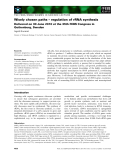
Cell cycle regulation and transcription
-
E2F transcription factors play an important role in the regulation of cell cycle progression. E2F6, the most recently identified member of the E2F family, is a retinoblastoma-protein-independent transcriptional repressor that is required for developmental patterning of the axial skeleton. It has recently been shown that theE2f6locus produces two different mRNAs, E2F6 and E2F6b. The E2F6b mRNA contains an additional exon that is inserted by alternative splicing.
 7p
7p  tumor12
tumor12
 22-04-2013
22-04-2013
 33
33
 1
1
 Download
Download
-
Ribonucleotide reductase is essential for the synthesis of all four dNTPs required for DNA replication. The enzyme is composed of two proteins, R1 and R2, which are both needed for activity. Expression of the R1 andR2mRNAs is restricted to the S-phase of the cell cycle, but the R1 andR2 promoters shownoobvious sequence homologies that could indicate coordination of transcription.
 11p
11p  fptmusic
fptmusic
 16-04-2013
16-04-2013
 40
40
 3
3
 Download
Download
-
The finding of a genome-wide oscillation in transcription that gates cells into S phase and coordinates mitochondrial and metabolic functions has altered our understanding of how the cell cycle is timed and how stable cellular phenotypes are maintained.
 13p
13p  media19
media19
 06-03-2013
06-03-2013
 37
37
 4
4
 Download
Download
-
Type 2A serine⁄threonine phosphatases are part of the PPP subfamily that is formed by PP2A, PP4 and PP6, and participate in a variety of cellular processes including transcription, translation, regulation of the cell cycle, signal transduction and apoptosis.
 14p
14p  media19
media19
 05-03-2013
05-03-2013
 37
37
 3
3
 Download
Download
-
Recently, the conserved human LINC⁄DREAM complex has been described as an important regulator of cell cycle genes. LINC consists of a core module that dynamically associates with E2F transcription factors, p130 and the B-MYB transcription factor in a cell cycle-dependent manner. In this study, we analyzed the evolutionary conserved LIN54 subunit of LINC.
 14p
14p  viettel02
viettel02
 20-02-2013
20-02-2013
 40
40
 3
3
 Download
Download
-
All cells, from prokaryotes to vertebrates, synthesize enormous amounts of rRNA to produce 1–2 million ribosomes per cell cycle, which are required to maintain the protein synthesis capacity of the daughter cells. In recent years, considerable progress has been made in the elucidation of the basic principles of transcriptional regulation and the pathways that adapt cellular rRNA synthesis to metabolic activity, a process that is essential for under
 14p
14p  viettel02
viettel02
 19-02-2013
19-02-2013
 42
42
 2
2
 Download
Download
-
Mutations in the tumor suppressor breast cancer susceptibility gene 1 (BRCA1), an important player in the DNA damage response, apoptosis, cell cycle regulation and transcription, confer a significantly elevated life-time risk for breast and ovarian cancer.
 11p
11p  viettel02
viettel02
 19-02-2013
19-02-2013
 51
51
 2
2
 Download
Download
-
The cell cycle-dependent element (CDE) and the cell cycle genes homology region (CHR) control the transcription of genes with maximum expression in G2 phase and in mitosis. Promoters of these genes are repressed by pro-teins binding to CDE⁄CHR elements in G0 and G1 phases. Relief from repression begins in S phase and continues into G2 phase and mitosis.
 17p
17p  mobifone23
mobifone23
 18-01-2013
18-01-2013
 47
47
 5
5
 Download
Download
CHỦ ĐỀ BẠN MUỐN TÌM





















